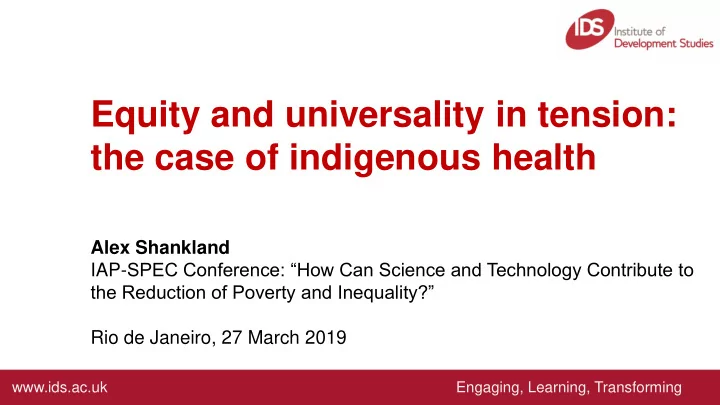

Equity and universality in tension: the case of indigenous health Alex Shankland IAP- SPEC Conference: “How Can Science and Technology Contribute to the Reduction of Poverty and Inequality?” Rio de Janeiro, 27 March 2019 www.ids.ac.uk Engaging, Learning, Transforming
IDS work on poverty and inequality www.ids.ac.uk Engaging, Learning, Transforming
Research with indigenous peoples and other ‘Traditional Peoples and Communities’ • IDS has a long history of working on water, forest management, climate adaptation and other issues with indigenous, tribal and ethnic minority peoples in many parts of the world including India, South Africa, Uganda, Kenya, Guatemala, Vietnam and the Philippines. • In Brazil, we have worked on improving indigenous peoples’ access to health services for more than a decade, collaborating with government agencies, research institutions, indigenous peoples’ movements, civil society groups and front-line professionals, most recently through the ESRC/DFID funded ‘ Vozes Desiguais / Unequal Voices’ project. www.ids.ac.uk Engaging, Learning, Transforming
Indigenous peoples, their territories and the SDGs • An estimated 370 million indigenous people live in more than 70 countries around the world. • The world’s ability to meet the Sustainable Development Goals for poverty and hunger (SDG1 and SDG2) depends on ensuring that these communities are are ‘not left behind’. • The territories of indigenous and traditional communities also protect the world’s most important reserves of biodiversity (SDG15) and sources of fresh water (SDG6) • Ensuring that they retain access to and control over these territories and are able to live healthy lives within them is a key requirement for inequality reduction (SDG10) www.ids.ac.uk Engaging, Learning, Transforming
Indigenous health and the inequity challenge • In 2005, a series of studies commissioned by The Lancet concluded that indigenous peoples were ‘behind everyone, everywhere’. • A decade later, the Lancet – Lowitja Institute Global Collaboration on Indigenous and Tribal Peoples’ Health found continued Above: from Anderson et al. (2016) ‘ Indigenous prevalence of ‘poorer health and social and tribal peoples’ health (The Lancet– Lowitja Institute Global Collaboration): a population outcomes for Indigenous peoples than for study’ The Lancet Vol 388, p. 150 non- Indigenous populations’. Right: from Stephens et al. (2006) ‘Disappearing, displaced, and undervalued: a call to action for Indigenous health worldwide’ • What will it take to transform this situation The Lancet Vol 367, p.2022 by 2030? www.ids.ac.uk Engaging, Learning, Transforming
A rights-based approach to the inequity challenge? Indigenous rights and health rights • Indigenous rights have been gaining visibility globally, symbolized by the 2007 UN Declaration on the Rights of Indigenous Peoples (UNDRIP) and the establishment of the UN Permanent Forum on Indigenous Issues (UNPFII) • UNDRIP and related international legal frameworks guarantee rights both to ‘access to health services and social security’ and to ‘traditional health practices’. • Brazil’s 1988 Constitution guarantees all citizens the right to health and also guarantees indigenous peoples the right to cultural self-determination. www.ids.ac.uk Engaging, Learning, Transforming
Universal health coverage as a pathway to realising indigenous health rights in Brazil? • Since 1988, Brazil’s Sistema Único de Saúde (SUS) has become a global model for rapid and cost-effective achievement of universal health coverage. • This has been the result of local innovation in primary care models such as the Estratégia de Saúde da Família (ESF), followed by effective scaling up of nationally standardised versions. • To tackle health inequities affecting indigenous peoples, Brazil has created an ‘Indigenous Health Subsystem’ of the SUS targeting coverage of indigenous territories. www.ids.ac.uk Engaging, Learning, Transforming
The limits of rights-based standard-package rollout in indigenous health • Brazil’s Indigenous Health Subsystem has seen very significant funding growth since its establishment in 1999, but despite adopting the same strategies and programmes as the SUS as a whole its performance has lagged behind. • This has led to intense political debate, waves of indigenous protest and now to a proposal to break up the Subsystem, cut budgets and return some responsibilities to municipal health departments. • What explains the poor performance of the Indigenous Health Subsystem? In the current Brazilian political climate, the default explanation for the situation is ‘corruption’ – which may exist, but is insufficient to explain this level of failure. www.ids.ac.uk Engaging, Learning, Transforming
Why is ‘more of the same’ not enough to overcome the inequities that characterise indigenous health? • Realising indigenous health rights requires addressing complex challenges which do not fit the standard package rollout model. • Indigenous territories are often remote, their epidemiology and their societies are little- understood, and their political relations with majority societies are marked by power inequalities and often by conflict. • Even though overall costs can be reduced significantly by improving management and governance, this complexity means that per capita costs will remain higher than for service delivery to the urban poor. www.ids.ac.uk Engaging, Learning, Transforming
So why invest scarce resources in addressing the health inequities affecting indigenous peoples? • Transforming the health status of 370 million of the world’s poorest people by 2030 is essential to preserve the credibility of the SDG promise to ‘leave no one behind’ – but beside this moral and political imperative, it also promises practical benefits. • Health systems are becoming increasingly complex, and management approaches based on rolling out standard packages can no longer help them to meet the needs of rapidly-changing societies. – Developing more diverse, decentralised and adaptive health service delivery models that can respond flexibly to indigenous peoples’ epidemiological, social and cultural realities will help us to reimagine all health systems to benefit everyone. • Indigenous peoples are guardians of biodiversity reserves with enormous pharmaceutical potential, and also of immense knowledge on holistic approaches to health and wellbeing. – Working alongside indigenous health specialists to improve the health of their peoples will allow us to learn from them how to meet the complex health needs of our own societies. • However, securing these benefits will require both political commitment and new partnerships between biomedical scientists, social scientists and indigenous knowledge-holders. www.ids.ac.uk Engaging, Learning, Transforming
Recommend
More recommend